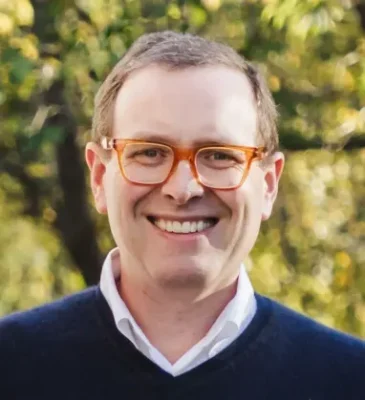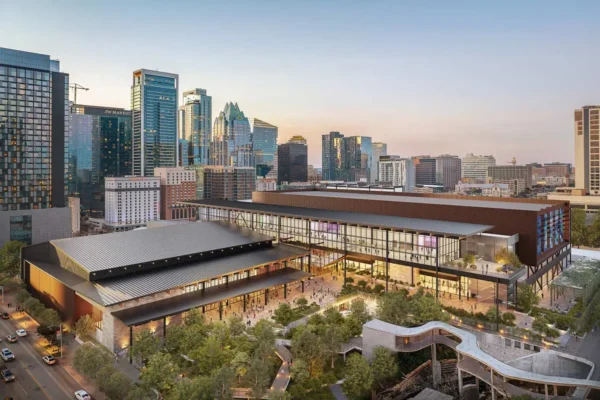Choosing to use tension fabric in a booth design opens up a world of possibilities. Fabric bends, moves and works in completely different ways than other materials, and it can be used and reused for many different exhibits.
“Shapes and curves that were previously unheard of in a tradeshow display are now possible,” said Michael Rigby, director of product development for PosterGarden. “You can shape and form fabric in ways that more traditional print materials simply cannot be used.”
Exhibit
What are the advantages of using fabric compared to other materials?
O’Rourke: Fabric is less expensive than standard modular components. It also offers a lower freight cost due to the lighter weight than other materials, fewer seams in fabric due to size constraints of raw materials.
McQuilkin: When compared to other display materials, tension fabric is lightweight and compact, saving money in shipping and drayage on the show floor, and in storage costs after the show is over. Tension fabric is also inherently flexible – you can create soft organic forms and shapes. With the new extrusion offerings that have become available in recent years, it is also possible to create rectilinear shapes that mimic hard surfaces.
Tension fabric is also inherently green. Its compact nature reduces energy associated with transportation. Also, tension fabric typically requires less packaging to prevent damage so waste is reduced.
Rigby: Fabric has a softer feel than other materials, giving it a much more friendly and inviting look. You can also shape and form fabric in ways that more traditional print materials simply cannot be used.
Does your company recycle fabric or practice other environmental processes?
Rigby: We use fabrics that are made from recycled soda bottles whenever we can. Approximately 85 percent of our fabric production is done with fabrics that have recycled content.
O’Rourke: Yes, we currently have a company that takes a portion of our waste for re-use. We are also in the process of working with Tri Vantage to use their recycling program.
McQuilkin: Moss offers a wide range of fabrics with recycled content, which are becoming more and more popular.
What was the process like when entering the fabric industry?
McQuilkin: Moss’ history is steeped in fabric, so there was no real “entering” the industry. Moss started as a recreational tent manufacturer in the 1970s and started creating displays for our own tradeshows in the 80s. We quickly realized we were on to something new and exciting for the exhibits. The appeal of lightweight display materials was easily understood, but it took a lot of education of the industry to convince exhibitors that fabric could be an appropriate choice to replace hard materials.
Rigby: It was certainly a difficult learning curve. Printing on fabric is not like printing on films or papers. You have several new variables to consider such as weave, stretch and bias that you have to consider. We were also committed to creating fabric images that look like fabric images rather than ink sitting on top of fabric. This means using a two-step sublimation process to get the best results. But it was worth it; I’d be proud to compare the quality of our fabric prints against anyone in the market.
O’Rourke: In 1941, Art Lawrence started the company and named it Lawrence Canvas Products. The company mainly manufactured Tarpaulin’s for the over-the-road trucking industry. In 1996, we changed the name to Lawrence Fabric Structures because canvas was less than 2 percent of the fabric that we used. In January 2010, the word “metal” was added to our name so we could better market our products to the people that want just metal awnings, canopies, or framework. It was a natural progression with our long history of manufacturing.
Are there any common misconceptions about using fabric displays?
O’Rourke: A common misconception is that all fabrics are fire retardant. But the bigger issue is that many people are uneducated about the industry. Specifically, there is a lack of knowledge of what can be done and what fabrics are available.
McQuilkin: For the most part, the industry understands the value of using fabric in exhibits. I can’t think of any common misconceptions, but I think sometimes people are concerned about the durability/cleanability of fabric. We address these concerns by including a care kit with each shipment to both minimize potential issues and to help clean them up if they occur. We include gloves, drop cloths and fabric cleaners.
Rigby: One of the most common ideas is that fabric is harder to care for. In fact, I’d say it’s easier. All of our fabric prints are machine washable and if it gets dirty, simply throw it in the wash. You can’t do that with paper or vinyl!
What is a main issue to consider when integrating fabric into a booth?
Rigby: Fabric moves in ways that traditional materials do not. When in the design phase, take into account that a line that looks perfectly straight on paper may not appear perfectly straight when stretched across a curved frame. Make sure you design with the end display in mind.
O’Rourke: To make sure all the fabric textures/sheens/colors integrate in a complimentary fashion.
McQuilkin: The most important thing is to work with an exhibit builder who has experience working with fabric. They should have experience designing with fabric structures, creating artwork that is appropriate for fabric displays, and have experience setting up fabric displays on the show floor.
Does your company construct frames for fabric booths?
McQuilkin: We offer many options – round profile aluminum tubing and two extrusion lines. Providing frames allows us to offer our customers a complete display solution including back walls, hanging signs, kiosks, desks and conference rooms.
The advantage to end users looking for a tension fabric supplier is that if they use one that has frame, fabric and printing integrated into their manufacturing process, they can be sure that the graphics will fit the frame perfectly.
O’Rourke: Lawrence Fabric & Metal Structures Inc. has been known as the premier manufacturer of fabric products in the
It allows us to be able to offer a complete package for a client who wants all metal components along with framed fabric structures.
Rigby: Yes. It’s opened a whole new world for our customers. Shapes and curves that were previously unheard of in a tradeshow display are now possible. What’s more, is that there’s no end to the shapes that can be created.
Is video projection mapping on fabric going to be a major trend in the industry?
Rigby: It’s a very interesting technology that if used well can really draw interest to fabric display. With the wealth of new display technologies that are emerging in the 3D and display arena, I’m not convinced it will be a major trend. But it certainly has a place in the market, and when done well, it certainly will leave a lasting impression.
McQuilkin: I don’t know a lot about this trend. Fabric is a natural surface for projection and has been used for years.
We are seeing more trends in integrating more functional fabrics into displays. For example, fabrics that block or soften sound, fabrics that are ideal for projection of all kinds, or that have anti-microbial properties. Fabric is also being used not just for graphic elements but also to create conference rooms and storage areas or welcome desks or kiosks for product display.
O’Rourke: Light has always been a complimentary addition to exhibit displays, therefore, projection mapping is a natural progression. This major trend using standard white fabric allows for quick, inexpensive change of images, messages and logos.
Are tension fabric structures are becoming the “norm” for experiential design?
O’Rourke: “I believe 5 years ago, I would agree the industry was heading in the direction of fabric structures becoming the ‘norm.’ Now, due to the downturn in the economy, it has shifted to more of a 50/50 of fabric and wood.” (Quote from Jim Knoche)
Rigby: Yes, fabric allows an ease of use and practicality that other materials do not. Plus it gives you an infinite number possibilities form and texture.
McQuilkin: Fabric is becoming more and more widely used in exhibits, events, and retail environments. Not sure if it’s quite the “norm” yet.

































